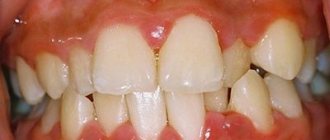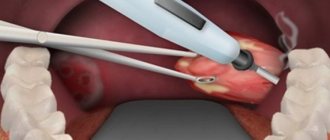Chronic tonsillitis is a long-term inflammatory process in the tonsils, which, in the absence of quality treatment, gives the patient a lot of unpleasant symptoms and can provoke serious complications in the heart, kidneys and joints. It is a mistake to think that only surgery will help cope with inflammation of the tonsils. Before deciding on surgical intervention, it is necessary to carry out comprehensive treatment of the tonsils without surgery. How to cure tonsils without surgery? Read in the new article.
Chronic tonsillitis is a chronic inflammatory process localized in the palatine tonsils. No one is immune from tonsil disease: neither an adult nor a child. With chronic inflammation, the disease occurs with periodic recurrences of symptoms: the tonsils increase in size, purulent plugs appear in them, and bad breath is felt. Then comes the resting stage, when the symptoms subside and the tonsils shrink in adults and children. This period is called remission.
Many patients, tired of a series of endless exacerbations, believe that only surgery will help get rid of the problem once and for all: removing the tonsils once is better than trying to treat them unsuccessfully. This opinion can be heard especially often from parents of frequently ill children who are tired of treating tonsils in children while constantly being on sick leave. And for them, surgery seems to be the only way out.
Others, on the contrary, are afraid of surgical intervention and believe that reducing tonsils without surgery in adults or children is a completely doable task.
How to reduce tonsils in a child without surgery? And is it possible to cure tonsils in adults without resorting to surgery? You will find the answers in our new article.
The meaning of the palatine tonsils
Before you think about performing an operation on an adult or child, you need to understand that nature does not create anything for nothing. And our tonsils are no exception. The tonsils are by no means a useless organ, the removal of which will pass without leaving a trace.
The palatine tonsils, despite their small size, are a powerful barrier that protects our body from viruses and bacteria. They consist of lymphoid tissue. When an infection gets on the surface of the tonsils, they begin to intensively produce leukocytes that kill pathogenic organisms. Then the defeated infection, along with the dead leukocytes, is excreted. This is how a healthy amygdala works.
External causes and weakened immunity reduce the protective properties of the tonsils. The tonsils of an adult or child stop coping; pathogenic microflora settles in their lacunae, maintaining constant inflammation in them. This is how chronic tonsillitis develops.
Pus plugs that appear on the surface of the tonsils are nothing more than a compressed infection.
This condition must be treated without fail. And surgery is only the most extreme option.
The structure of the tonsils and their number
Tonsils or otherwise tonsils consist of lymphoepithelial porous tissue. They are located in the nasopharynx in a circle and are part of the Pirogov-Waldeyer (pharyngeal-lymphatic) ring.
They are divided into paired and unpaired, there are 6 of them in total. The first group includes:
- Palatal. They are located on both sides of the pharynx in a depression formed by the tongue and soft palate.
- Pipe. Located next to the auditory tube.
Unpaired formations:
- Pharyngeal or nasopharyngeal. Located on the posterior fornix of the pharynx.
- Lingual. The location is the back of the root of the tongue.
Functions of the tonsils:
- Barrier. They trap and neutralize bacteria and viruses.
- Immunogenic. B and T lymphocytes are formed in the follicles of the tonsils.
- Hematopoietic. Active during the neonatal period.
- Enzymatic. The tissues of the organs secrete some enzymes necessary for the initial stage of digestion in the oral cavity.
The tonsils are also involved in the formation of voice timbre, so their defeat leads to hoarseness.
Causes of chronic inflammation of the tonsils
Inflammation in the tonsils in an adult or child is caused by streptococcus and staphylococcus bacteria, which begin to actively multiply and take root in the lacunae of the tonsils, poisoning the body with the products of their vital activity.
The causes of infection entering the tonsils may be:
- past infectious diseases;
- chronic diseases of the nose and paranasal sinuses (rhinitis, sinusitis);
- pharyngitis;
- dental diseases (caries);
- deviated nasal septum;
- nasal polyps;
- overgrown adenoid vegetations in a child;
- stress;
- allergic reactions;
- reduced immunity.
One of the most common causes of chronic inflammation is improperly treated or undertreated acute tonsillitis - a sore throat we all know.
Therefore, it is extremely important to begin treating the disease in the early stages, and treatment of tonsils in adults and children should initially be carried out by a competent otolaryngologist.
Under what conditions can tonsils be enlarged without fever?
Without an increase in temperature, the tonsils can become inflamed due to:
- Allergies. Enlarged tonsils often occur in people prone to allergies. Allergens include various substances - animal hair, dust, pollen, food, insects, household chemicals.
- Fungal infection. The following symptoms are observed: sore throat, dry mouth, visible cheesy coating on the mucous membrane.
- Dry air. Due to constant inhalation of dry air, the mucous membrane of the larynx dries out, causing the tonsils to swell. Working in polluted conditions also leads to this.
- Smoking. Tobacco smoke burns the mucous membrane, which can result in swelling of the tonsils.
- Some forms of sore throat (tonsillitis). The biological meaning of an increase in temperature during infectious diseases is to accelerate the death of pathogenic carriers in an environment with high temperatures. Consequently, if the body temperature has not increased, it means that the number of infectious carriers that have entered the body is small. Usually, if the infection was minor, then the person easily and quickly suffers from this illness. But with enlarged tonsils and no temperature, we can talk about an untreated acute inflammatory process in the tissues of the tonsils and its transition to chronic. In this case, the recovery process will take longer, and in addition, there is a possibility of complications developing. Both variants of pathologies require examination and prescription of correct treatment by an otolaryngologist.
How does the disease manifest?
With prolonged chronic inflammation of the tonsils, pathological processes occur in them: the lymphoid tissue changes to connective tissue, the winding channels of the tonsils - the crypts - narrow, and the ability to self-cleanse disappears. Intoxication of the body becomes more and more pronounced.
The disease is manifested by the following symptoms:
- enlargement and redness of the tonsils, their tissues become loose;
- purulent plugs in lacunae;
- increase in body temperature to 37.5℃;
- a sore throat;
- bad breath;
- fast fatiguability;
- weakness.
We also need to understand that if the tonsils are not treated, regardless of whether the patient in front of us is an adult or a child, this is a constant source of infection that can spread throughout the body.
Medical statistics say that chronic tonsillitis is a common cause of the development of kidney, heart and joint diseases.
It is necessary to take into account the possibility of these complications and begin treating chronic tonsillitis in a timely manner.
Treatment.
An effective treatment tactic will be chosen by an ENT doctor only after the cause of tonsil hypertrophy has been established.
Depending on the cause of inflammation, the patient is prescribed:
- antibacterial drugs if the causative agent of the disease is bacteria. Moreover, the medicine must be taken “from start to finish” - a strictly defined number of days, even if the child feels better. Continuous treatment is the key to a quick recovery without complications;
- antiviral drugs, if the causative agent of the disease is a viral infection;
- antifungal agents, if the cause of inflammation is fungi;
- gargling and irrigating the throat with antiseptics - constantly gargling is necessary to wash away pathogenic flora from the mucous membranes;
- antihistamines to relieve tissue swelling, and if the cause of throat discomfort is an allergic reaction;
- washing the lacunae of the palatine tonsils from pathogenic flora (it is optimal to start washing from 6-7 years of age);
- physiotherapeutic procedures (laser, ultrasound, photodynamic therapy, ultraviolet exposure, etc.)
Some parents believe that it is easier to remove the tonsils and get rid of the problems associated with them. But this is not a solution! Removal requires strict indications: more than four sore throats during the year, bad rheumatic tests, peritonsillar abscess and complications in the heart, kidneys and joints. If there are no indications, you need to be observed by an ENT doctor and, if necessary, carry out timely treatment.
Surgery to remove tonsils
The importance of the tonsils cannot be underestimated. We found this out at the very beginning of the article. The main goal of any therapy is to try to reduce the tonsils without surgery and preserve them as an organ of the immune system. Many adult patients mistakenly believe that they will have less pain after surgery. It is a myth! Yes, the tonsils will stop bothering you. But now the infection from the outside will enter the pharynx and further into the respiratory tract without encountering any obstacle, which will not have the best effect on the incidence of respiratory tract diseases.
The operation to remove the tonsils is called tonsillectomy.
Certain indications are required for the operation. The patient's fatigue due to frequent exacerbations and unpleasant symptoms is not such an indication.
Surgical intervention is prescribed in the following cases:
- recurrence of sore throats more than four times throughout the year;
- a peritonsillar abscess that has occurred;
- poor performance of rheumatic tests;
- complications on other organs and systems of the patient.
Before deciding to undergo surgery, it is necessary to try to treat a child or adult patient conservatively, that is, to reduce the tonsils without surgery.
Prevention
To prevent pathological enlargement of the tonsils, you must adhere to the following recommendations:
- Increase immunity: eat properly and well, exercise, exercise, give up bad habits, and maintain proper sleep patterns.
- Avoid provoking factors: do not overcool, humidify the air in the room, remove allergens from the environment.
- Treat infectious diseases promptly at the very beginning and prevent them from becoming chronic.
- Carry out preventive gargling and rinsing of tonsil lacunae. These procedures are carried out in our clinic, and our doctors will be happy to advise you about them.
If you are concerned about enlarged tonsils without fever, make an appointment with otolaryngologists at the Ear, Nose and Throat Clinic - you will receive comprehensive consultations and quality treatment.
Diagnostics
- Anamnesis collection, visual examination and palpation of the mucous membranes of the floor of the mouth, the anterior two-thirds of the tongue, the tonsils and base of the tongue, the mucous membrane of the palate, cheeks and gums, and the posterior wall of the pharynx.
- Diagnosis of HPV infection: immunohistochemical determination of the surrogate marker p16 in tumor tissue.
- Computed tomography of the chest and abdominal cavity to exclude metastatic lesions.
- Biopsy – cancer can be diagnosed only by taking a tissue sample from a growth that is suspicious for a malignant process.
- MRI of the soft tissues of the neck provides more accurate detail of the soft tissues compared to CT. Performed to assess the prevalence of the process.
- Ultrasound of the lymph nodes of the neck to determine their structure (if there is metastasis in the lymph nodes, they may not change their size, but the structure of the lymph node changes).
- PET-CT may be ordered if occult distant metastases are suspected in some situations.
- Fibercolonoscopy, fibrogastroduodenoscopy, laryngoscopy and some other studies may also be prescribed.
HPV-associated squamous cell carcinoma of the right tonsil (A) demonstrating p16 overexpression by immunohistochemistry (B) and evidence of high-risk HPV by in situ hybridization (C). Patients with HPV-related tonsil squamous cell carcinoma rarely harbor oncogenic HPV infection at other pharyngeal sites, SelvamThavaraj et all., ELSEVIER April 2014
Physiological manifestations of loose tonsil syndrome
If your child is often sick, you should definitely consult a specialist about chronic throat problems.
Tonsils are small formations of lymphatic tissue. There are 6 of them in total, but only three are of concern - a pair of palatine tonsils and a nasopharyngeal tonsil. Pathologies of the palatine tonsils (tonsils) lead to tonsillitis, and enlargement of the nasopharyngeal tonsils leads to adenoids. It is these tonsils in the body that have received the honor of being called “loose” and here’s why.
They have a heterogeneous structure with small depressions. The palatine tonsils even have large “craters” - lacunae. During various inflammatory processes, swelling of the organ tissue is observed, and the lacunae can increase and become clogged with accumulations of microorganisms that form plugs in the tonsils. In chronic diseases, the tissue of the organ changes, swells and enlarges, which creates the effect of loose tonsils - the photo shows what it looks like.
In official medicine, the term “loose tonsils” is not used.
You can detect enlarged and loose tonsils yourself; you just need to arm yourself with a mirror. If the tonsils are swollen and in the mirror you can see the heterogeneity of their structure - this is the so-called “syndrome” of loose tonsils.
Healthy tonsils are distinguished by a pink tint and a smooth structure; they do not stand out too much and are quite dense in themselves. But with chronic diseases, the tonsils become loose, look unhealthy and often bother the person.
Loose tonsils have a swollen, inflamed appearance







